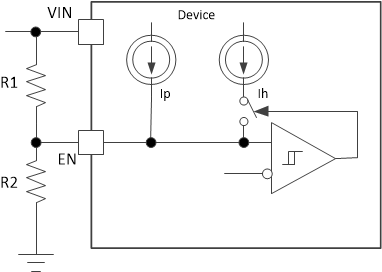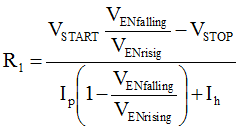JAJSFQ3A July 2018 – September 2019 TPS56637
PRODUCTION DATA.
- 1 特長
- 2 アプリケーション
- 3 概要
- 4 改訂履歴
- 5 Pin Configuration and Functions
- 6 Specifications
-
7 Detailed Description
- 7.1 Overview
- 7.2 Functional Block Diagram
- 7.3
Feature Description
- 7.3.1 The Adaptive On-Time Control and PWM Operation
- 7.3.2 Mode Selection
- 7.3.3 Soft Start and Pre-Biased Soft Start
- 7.3.4 Enable and Adjusting Undervoltage Lockout
- 7.3.5 Output Overcurrent Limit and Undervoltage Protection
- 7.3.6 Overvoltage Protection
- 7.3.7 UVLO Protection
- 7.3.8 Thermal Shutdown
- 7.3.9 Output Voltage Discharge
- 7.3.10 Power Good
- 7.4 Device Functional Modes
- 8 Application and Implementation
- 9 Power Supply Recommendations
- 10Layout
- 11デバイスおよびドキュメントのサポート
- 12メカニカル、パッケージ、および注文情報
7.3.4 Enable and Adjusting Undervoltage Lockout
The EN pin provides electrical on and off control of the device. When the EN pin voltage exceeds the threshold voltage, the device begins operating. If the EN pin voltage is pulled below the threshold voltage, the regulator stops switching and enters the standby operation.
The EN pin has an internal pull-up current source which allows the user to float the EN pin to enable the device. If an application requires control of the EN pin, open-drain or open-collector output logic can be used to interface with the pin.
The TPS56637 implements internal undervoltage-lockout (UVLO) circuitry on the VIN pin. The device is disabled when the VIN pin voltage falls below the internal VIN UVLO threshold. The internal VIN UVLO threshold has a hysteresis of 500 mV.
If an application requires a higher UVLO threshold on the VIN pin, then the EN pin can be configured as shown in Figure 16. When using the external UVLO function, setting the hysteresis at a value greater than 500 mV is recommended.
The EN pin has a small pull-up current, Ip, which sets the default state of the pin to enable when no external components are connected. The pull-up current is also used to control the voltage hysteresis for the UVLO function because it increases by Ih when the EN pin crosses the enable threshold. Use Equation 2 , and Equation 3 to calculate the values of R1 and R2 for a specified UVLO threshold. Once R1, R2 were settled down, the VEN voltage can be calculated by Equation 4, which should be lower than 5.5V with max VIN.
 Figure 16. Adjustable VIN Undervoltage Lockout
Figure 16. Adjustable VIN Undervoltage Lockout 


Where
- Ip = 1 µA
- Ih = 4 µA
- VENfalling = 1.12 V
- VENrising = 1.18 V